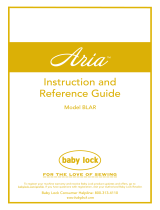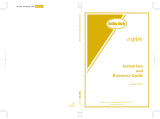
CONTENTS
x
CONTENTS
INTRODUCTION...................................................i
IMPORTANT SAFETY INSTRUCTIONS ..................i
OUTSTANDING FEATURES .................................vi
WHAT YOU CAN DO WITH THIS MACHINE ...viii
HOW TO USE THIS MANUAL .............................ix
NAMES OF MACHINE PARTS AND THEIR
FUNCTIONS ...........................................................1
Machine..................................................................................1
Needle and Presser Foot Section .............................................2
Embroidery Unit......................................................................3
Operation Buttons ...................................................................3
Using the Flat Bed Attachment ................................................4
Using the Accessory Case........................................................4
Storing Bobbin Clips................................................................5
Using the Embroidery Unit Carrying Case ...............................5
Included Accessories...............................................................5
Options...................................................................................8
Using the Spool Stand .............................................................9
Chapter 1 Getting Ready 11
TURNING THE MACHINE ON/OFF....................12
LCD SCREEN .......................................................14
USB Connectivity ..................................................................18
Using the Machine Setting Mode Key ...................................22
Using the Sewing Machine Help Key ...................................32
Using the Operation Guide Function.....................................33
Using the Sewing Guide Function .........................................34
Using the Pattern Explanation Function.................................35
LOWER THREADING ..........................................37
Winding the Bobbin ..............................................................37
Setting the Bobbin .................................................................43
Pulling Up the Bobbin Thread ...............................................45
UPPER THREADING............................................46
Upper Threading ...................................................................46
Using the Twin Needle Mode................................................49
Using the Spool Stand ...........................................................52
Using Threads that Unwind Quickly .....................................53
CHANGING THE PRESSER FOOT .......................54
Removing the Presser Foot ....................................................54
Attaching the Presser Foot .....................................................54
Attaching the Walking Foot...................................................55
CHANGING THE NEEDLE...................................56
About the Needle ..................................................................58
Fabric/Thread/Needle Combinations .....................................58
Chapter 2 Sewing Basics 59
SEWING ..............................................................60
Sewing a Stitch......................................................................60
Sewing Reinforcement Stitches..............................................62
Sewing Curves.......................................................................62
Changing Sewing Direction...................................................63
Sewing Heavyweight Fabrics.................................................63
Sewing Hook-and-Loop Fastener...........................................64
Sewing Lightweight Fabrics ...................................................64
Sewing Stretch Fabrics...........................................................65
STITCH SETTINGS...............................................66
Setting the Stitch Width .........................................................66
Setting the Stitch Length ........................................................67
Setting the Thread Tension ....................................................67
USEFUL FUNCTIONS..........................................69
Automatic Reinforcement Stitching .......................................69
Automatic Thread Cutting .....................................................70
Using the Knee Lifter .............................................................71
Pivoting.................................................................................72
Automatic Fabric Sensor System
(Automatic Presser Foot Pressure) ..........................................73
Needle Position – Stitch Placement....................................... 74
Locking the Screen ............................................................... 74
Checking the Needle Location in the Screen......................... 75
Chapter 3 Utility Stitches 77
SELECTING UTILITY STITCHES .......................... 78
Selecting a Stitch .................................................................. 79
Saving Your Stitch Settings.................................................... 81
SEWING THE STITCHES ..................................... 83
Straight Stitches .................................................................... 83
Dart Seam............................................................................. 88
Gathering ............................................................................. 88
Flat Fell Seam ....................................................................... 89
Pintuck ................................................................................. 90
Zigzag Stitches...................................................................... 91
Elastic Zigzag Stitches........................................................... 93
Overcasting .......................................................................... 94
Quilting ................................................................................ 99
Blind Hem Stitches ............................................................. 111
Appliqué............................................................................. 113
Shelltuck Stitches................................................................ 114
Scallop Stitches................................................................... 115
Crazy Quilting .................................................................... 116
Smocking Stitches............................................................... 116
Fagoting.............................................................................. 117
Tape or Elastic Attaching .................................................... 117
Heirloom............................................................................ 119
One-step Buttonholes ......................................................... 121
Four-step Buttonholes ......................................................... 125
Bar Tacks............................................................................ 129
Button Sewing .................................................................... 131
Eyelet.................................................................................. 133
Multi-directional Sewing (Straight Stitch and Zigzag Stitch) ......... 134
Zipper Insertion .................................................................. 135
Edge Sewing ....................................................................... 138
Chapter 4 Character/Decorative Stitches 145
SELECTING STITCH PATTERNS ........................ 146
Selecting Decorative Stitch Patterns/7mm Decorative Stitch
Patterns/Satin Stitch Patterns/7mm Satin Stitch Patterns/
Cross Stitch/Utility Decorative Stitch Patterns ..................... 148
Alphabet Characters ........................................................... 148
SEWING STITCH PATTERNS ............................ 152
Sewing Attractive Finishes .................................................. 152
Basic Sewing ...................................................................... 152
Making Adjustments ........................................................... 153
EDITING STITCH PATTERNS............................ 155
Changing the Size............................................................... 157
Changing the Length (for 7mm Satin Stitch Patterns Only)........... 157
Creating a Vertical Mirror Image......................................... 157
Creating a Horizontal Mirror Image .................................... 158
Sewing a Pattern Continuously ........................................... 158
Changing Thread Density (for Satin Stitch Patterns Only) .... 158
Returning to the Beginning of the Pattern............................ 159
Checking the Image ............................................................ 160
COMBINING STITCH PATTERNS..................... 162
Before Combining............................................................... 162
Combining Various Stitch Patterns ...................................... 162
Combining Large and Small Stitch Patterns......................... 164
Combining Horizontal Mirror Image Stitch Patterns ............ 165
Combining Stitch Patterns of Different Length..................... 165
Making Step Stitch Patterns (for 7mm Satin Stitch Patterns Only)...... 166
USING THE MEMORY FUNCTION .................. 169
Stitch Data Precautions....................................................... 169
Saving Stitch Patterns in the Machine’s Memory ................. 171
Saving Stitch Patterns to USB Media ................................... 174
Saving Stitch Patterns in the Computer................................ 175
Retrieving Stitch Patterns from the Machine’s Memory ....... 176


























